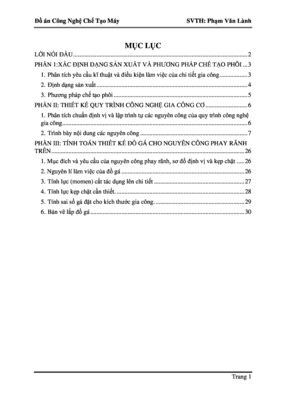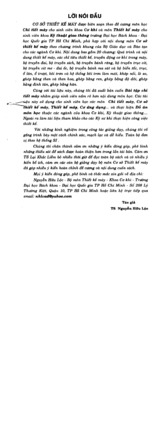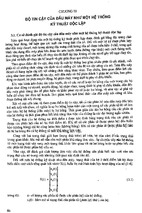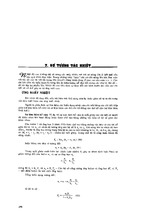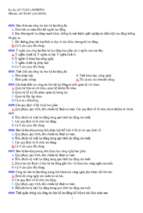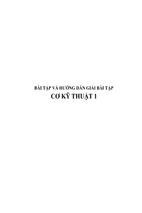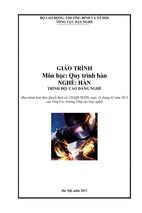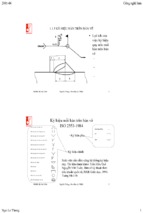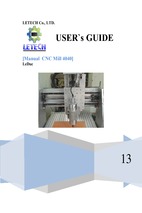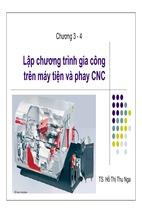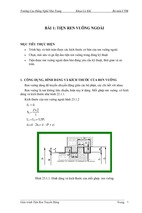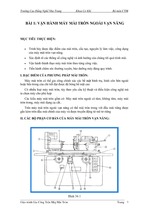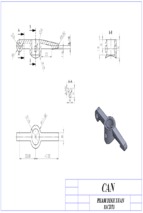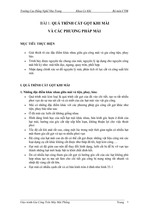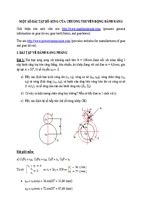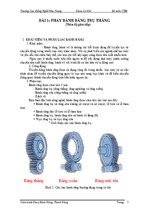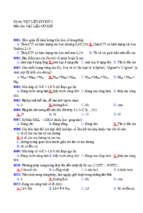Mô tả:
Adhesive Manufacturing Processes
Chapter 9: Process Technology
Univ.-Prof. Dr.-Ing. Prof. h.c. Stefan Böhm
Department for Cutting and Joining Manufacturing Processes (tff)
University of Kassel, Germany
Quelle: Wikipedia
Agenda
Introduction
Storing, Conveying
Mixing
Dosing, Application
Joining, Fixation
Curing, Handling
2
Introduction
Process technology for handling of adhesive primarily dependent on:
● Production technology, state on delivery (e.g. viscosity)
● Batch size (small-, medium- oder big batch production)
● Possibility of automation of adhesive process
● Circumstances in area of use (tools available, environmental conditions etc.)
● Ecological factors (containing solvent)
3
Einleitung
Stress
•
•
•
mechanical
•
•
•
•
•
•
•
Adhesion
tension
Compression
peeling
crash
On adherend
On pre-treated surface
•
•
•
•
•
•
chemical
Climate
thermal (changing)
filling, coating
Spray-coating, airless
1C-, 2C- batching
devices
Dip-Coating
Mesh-printing
Stamp-printing
Solvent containing
adhesives
Degreaser (FKW, CKW)
Pre-treatment dipping
Curing
Application
•
•
•
Environment
Optics
•
•
functional
decorative
Curing Time
•
•
•
Pot Life
Gelation Time
Complete Curing
Time
•
•
•
•
•
•
•
•
•
•
Ambient Temperature
Oven
IR-Emitter
UV-Emitter
Electron Beam
Induction
Microwaves
Initiator
2. Component
Anaerobic conditions
4
Introduction
Process Flow for adhesive bonding
Stocking Up /
Storing
Conveying
Mixing
Conveying
Application
Joining
Fixation
Curing
Handling
5
Agenda
Introduction
Storing, Conveying
Mixing
Dosing, Application
Joining, Fixation
Curing, Handling
6
Storing & Conveying
Storing & Converying of adhesives mostly dependend on components,
curing conditions & production
e.g. limited shelf life or special specifications for
storing temperature
Differentiation between three
states of adhesives:
1. liquid
2. Paste-like
3. solid
7
Storing & Conveying
1.
Liquid
● Possibility of separation or thickening due
to long or leaky storing conditions (phase
transitions)
Homogenisation by mixing
– Manual Agitator
– Air Pressure powered agitator
– Electrical powered agitator
● Some conditions may require constant
agiation (e.g. when solid components like
Siliciumcarbide-powder tend to sink)
Quelle: Endlich
8
Storing & Conveying
1.
Liquid
● Different storing possibilites:
Open falling
container
Quelle: Endlich
Pre-pressurised
Container with riser
Pre-pressurised
Container with
plunger
Pre-pressurised
Container with
bottom pipe
Mechanical plunger
pump
Conveying of Adhesive:
Container equipped
with valve
lower/excess pressure
required.
9
Storing & Conveying
2.
Paste-like
● Adhesives with high viscosity
● Hardly any separation of components
● Problem: Conveying
viscous input of heat necessary
● Most commom stored in heatable barrels
(see figure)
Heated hose and barrel
Quelle: Endlich und http://www.elkume.at/new-page/fassheizungen.html
10
Storing & Conveying
3.
Solid
● Available types of hot melt adhesives:
– Granulate
– Filament
– Zylindric cartridge (see figure)
– Cartridge filling
Usage depends on the form of supplay
and user tool
Hotmelt application
device, adhesive is
inserted as a ‚stick‘
Quelle: Endlich und http://www.kreativ-depot.de/Werkzeug-Kleber/Klebstoffe/Heissklebepistolen-Klebesticks/Heissklebepistolen/Heissklebepistole-Mini-Klebepistole-110-240-V-20W.html#!prettyPhoto
11
Storing & Conveying
3.
Solid
Gear
● Barrel melting facilities mostly for series
manufacturing
Heated hose
● Melting of solid adhesive
● Pressure sensitive adhesives usually
Actuator
come on rolls (see left figure)
Heated
plate
Barrel press with
heated plate
Quelle: Endlich und http://www.jk-tesa-shop.de/tesa-Easy-Cut-57421
Original
container
12
Storing & Conveying
Small batch series manufacturing
● Advantage:
Low investments
● Disadvantages:
Manuell filling of stocking container
Risk of air entrapment
No processing of air-sensitive or high
viscous adhesives
Quelle: Endlich
13
Storing & Conveying
Big batch size manufacturing
● Advantages:
High amount of adhesives necessary
(higher level of automation)
Processing of almost all types of
adhesives possible
● Disadvantages:
High cleaning expenses when changing
adhesive
High investment
Quelle: Endlich
14
Agenda
Introduction
Storing, Conveying
Mixing
Dosing, Application
Joining, Fixation
Curing, Handling
15
Mixing
Mixing of adhesives most frequently necessary for multicomponent
adhesives
As soon as the chemical counterparts get together the chemical curing
process is initiatied
It is important to meet the pot time (the time from mixing the components
till the end of processability)
Pot time can be extended by cooling
Three major types of mixing:
1. Batchwise mixing
2. Static mixing
3. Dynamic mixing
Quelle: Endlich
16
Mixing
1. Batchwise mixing
● Mostly for manual processing with small batch size because:
– Usage is rare
– Necessary amount is small (e.g. SMD-bondings)
– Mobile mixing solutions are required (e.g. at construction sites)
● Mixing in single-use cups (see figure)
Quelle: Endlich
17
Mixing
1. Batchwise mixing
● Correct mixing ratio is essential (otherwise, final
strenght of bond cannot be reached)
Components of adhesives are supplied in cartridges
(see figure)
● Mixed in air can be a problem Solution: Vacuum
batch mixer (see figure)
● Disadvantages:
– Manpower requirements
– Personal protection due to possibility of dangerous
materials
Quelle: Endlich
– Possibility of human failure (Wrong mixing ratio)
18
Mixing
2.
Static Mixing
● Fixed (static) mixing elements (usually mixer nozzles)
● Laminar liquid flows are pressurised and twisted
● Prinicple: Every mixing element splits the liquid stream contrarian parallel
or radial rotation induces mixing
„Layer “-formula: s=2n (s: Number of layers; n: number of mixing elements)
Example : n=3 s=23=8
(see figure)
Mixing nozzle with
parallel splitting of
streams
Quelle: Endlich
19
Mixing
2.
Static Mixing
● Static mixing nozzles create a drop in pressure
Compensation with conveying pump necessary
● Calculation:
(fs: Mixing factor; : Viscosity;
v: Volume flow; D: inside diameter of mixing nozzle; n: number of mixing
elements)
One-time mixing
nozzle
• Mostly for 2CAdhesives
Quelle: Endlich und Habenicht
20
- Xem thêm -


